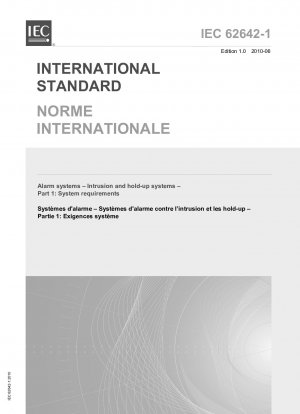IEC 62642-1:2010
Alarm systems - Intrusion and hold-up systems - Part 1: System requirements
- Standard No.
- IEC 62642-1:2010
- Release Date
- 2010
- Published By
- International Electrotechnical Commission (IEC)
- Latest
- IEC 62642-1:2010
- Scope
- This part of IEC 62642 specifies the requirements for Intrusion and Hold-up Alarm Systems (I&HAS) installed in buildings using specific or non-specific wired interconnections or wire-free interconnections. These requirements also apply to the components of an I&HAS installed in a building which are normally mounted on the external structure of a building e.g. ancillary control equipment or warning devices. The standard does not include requirements for exterior I&HAS. This International Standard specifies performance requirements for installed I&HAS but does not include requirements for design, planning, installation, operation or maintenance. These requirements also apply to I&HAS sharing means of detection, triggering, interconnection, control, communication and power supplies with other applications. The functioning of an I&HAS is not adversely influenced by other applications. Requirements are specified for I&HAS components where the relevant environment is classified. This classification describes the environment in which an I&HAS component may be expected to function as designed. When the requirements of the four environmental classes are inadequate, due to the extreme conditions experienced in certain geographic locations, special national conditions are given in Annex A. General environmental requirements for I&HAS components are described in Clause 7. The requirements of this standard also apply to IAS and HAS when these systems are installed independently. When an I&HAS does not include functions relating to the detection of intruders, the requirements relating to intrusion detection do not apply. When an I&HAS does
IEC 62642-1:2010 history
- 2010 IEC 62642-1:2010 Alarm systems - Intrusion and hold-up systems - Part 1: System requirements
